Pollinator Update
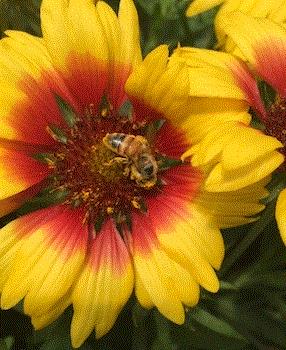
I’m frequently asked for updates on pollinator research and the factors that influence pollinator health and thought I’d take a few moments to share with you where these topics stand today.
For the time being, it may not matter what your opinion is or what science has proven. The current reality is pollinator health is front and center in the minds of many lobbyists and consumers. Although not the largest user of some of the chemistries linked to pollinator health, our industry is the flower industry and have used or currently use these products to manage pests in our crops.
Without taking one side or another, I think it’s clear this reality is here to stay. The focus on pollinator health will likely waver over time, ebbing and flowing around new research findings or perhaps the misuse of certain pesticides, similar to those incidences which started this whole controversy to begin with. Below you’ll find commentary and lots of links containing answers to many of the questions you and/or your customers likely have.

Neonics Update
This appears to be somewhat of a sticky subject. Some of the research appears rather incriminating while the results in other studies paint a different perspective. Additionally, there seems to be some controversy in how certain studies are being performed; do laboratory results transfer to the “real world?” The final verdict is still yet to be determined, but I invite you to read an article by fellow editor-at-large JC Chong, recently published in his PestTalks newsletter.

What happened to neonicotinoids in plants?
Another objective of the SCRI project is to find out how quickly systemic insecticides (not just neonicotinoids) degrade in plant tissues and how much ends up in nectar and pollen. To be comprehensive, we’ve conducted studies on both herbaceous plants and woodies, as well as both annuals and perennials.
Most of the research is still ongoing and not ready to make any conclusions. But, based on previous and ongoing research, it has become quite clear to us that systemic insecticides behave differently in plant tissues, and because of that, the amount of residues differs among insecticides, application methods, times of application and plant species.
The picture is quite complicated. Two recent studies illustrate that perfectly.
Bernie and Dan treated three groups of in-ground Clethra and Illex x attenuata with a soil drench of dinotefuran (Safari) and imidacloprid (Merit) with three treatments (spring, summer and fall). They extracted nectar from the flowers in early summer (during bloom) over 2 years and analyzed for insecticide residue in the nectar.
Results suggested that Merit and Safari, when applied at the labeled landscape rates in the fall of year one and spring of year two, can result in an amount of residue detrimental to bees in year two but not in year three. An obvious recommendation is to reduce the application rate so the residue can dissipate quicker, but it is not clear if doing so will reduce the insecticide's effectiveness. Another surprise is that application of Merit just after bloom in the summer resulted in low residue concentrations in nectar after one year, but application of Safari at the same time did not. The results highlight the point that neonicotinoids are not created equal. (The study was published in Environmental Toxicology and Chemistry, DOI: 10.1002/etc.4021.)
The second study comes from Rich Cowles and Brian Eitzer of Connecticut Agricultural Experiment Station (Journal of Environmental Horticulture, Volume 35, page 24-34). Rich and Brian treated sunflowers and swamp milkweed with a spray or drench (at labeled nursery rates) of Safari (dinotefuran), Flagship (thiamethoxam) and Xytect (imidacloprid) at 2, 4, 6, 8 and 10 weeks before bloom (only 2, 4 and 6 for milkweed).
Results suggested that spray application did not result in residue concentrations that were considered dangerous to bees being detected in the pollen of sunflowers. Drench applications of all insecticides at high rates, of medium rates of Xytect and Flagship up to 6 weeks before bloom, of medium rates of Safari up to 8 weeks before bloom, and of low rates of Safari up to 6 weeks before bloom could result in residue concentrations that are above the thresholds. Treating swamp milkweed with neonicotinoids, regardless of active ingredients, application timing and method, resulted in high concentrations of residue in nectar.
These studies demonstrate that the residue concentrations in nectar and pollen depend on different combinations of active ingredients, plant species, application method and application timing. Well, that just blew my mind. I’ll admit, it will take us many more studies to figure things out.
Check out JC’s February 20, 2018 edition of PestTalks for more coverage on pollinators.
I hope JC doesn’t mind, but I thought I’d let you know that he’s part of a research team funded by USDA Specialty Crops Research Initiative (SCRI) Grant to develop approaches to protect pollinators in the horticultural industry. He’d probably be a great resource to follow for updates on this research and/or to direct any related questions to.

It's Not That Simple
Before you throw in the towel on neonics and other pesticides, keep in mind that they are only part of the equation. There are numerous other factors and events which often affect bee health and survival.
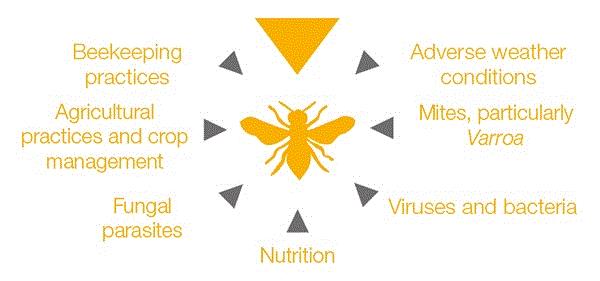 www.beecare.bayer.com
www.beecare.bayer.com
As the graphic above demonstrates, there are several variables that collectively influence the health and survival of bee hives. It’s not all about the pesticides. Just talk to a beekeeper; I’m almost certain you’ll hear them say they are losing more bees to Varroa mites and viruses than they are to pesticides. There’s no doubt pesticides play a role or can contribute to these losses, but step back and look at the whole picture and you’ll likely see it’s not as black and white as many would like you to believe.
Factors Affecting Honey Bee Damage
The following content was summarized from the UMass Extension website and was taken from an article titled “Toxicity of Pesticides to Pollinators and Beneficials.”
Many factors involving insecticide application affect the potential for honey bee losses. The most important factors are outlined below.
-
Plant Growth Stage: Severe bee poisoning most often results from spraying insecticides directly on flowering plants.
-
Relative Toxicity of the Chemical: Pesticides vary in their toxicity to honey bees. Most fungicides, herbicides and miticides are relatively nontoxic to honey bees and can generally be used around them without serious harm.
-
Choice of Formulation: Different formulations, even of the same pesticide, often vary considerably in their toxicity to bees. Dust formulations are typically more hazardous than sprays because they are picked up on bee hairs. A wettable powder would usually remain toxic in the field for a longer time than an emulsifiable concentrate. However, granular insecticides are less hazardous to honey bees. Microencapsulated materials are particularly dangerous to use around bees because the capsules have a special tendency to adhere to bees due to their size and electrostatic charge, and because the contaminated pollen collected by bees in the treated fields is stored in the hive and remains toxic for an extended period.
-
Residual Action: Residual activity of an insecticide is an important factor in determining its safety to pollinators. An insecticide which degrades within a few hours can generally be applied with minimum risk when bees are not actively foraging.
-
Drift: Drift of spray applications can cause significant bee poisoning problems, particularly when drift reaches colonies or adjacent flowering weeds. In general, sprays should not be applied if wind speed exceeds 10 mph and favors drift towards colonies.
-
Temperature: Temperature can have a substantial effect on the bee poisoning hazard. If temperatures following treatment are unusually low, insecticide residues can remain toxic to bees many times longer than if higher temperatures prevail.
-
Distance from Treated Fields: The most severely damaged colonies are usually those closest to fields where insecticides are being applied.
-
Time of Application: Evening application of a short residual insecticide can greatly reduce any potential for bee damage.
Read the complete article for more details on the above factors as well as what steps can be taken to reducing pesticide injury to honey bees. The article also includes a table outlining the poisoning hazard or how toxic certain pesticides are to honey bees. There’s also a table showing the toxicity of various pesticides to birds, fish, bees and beneficials (mite and aphid predators).
Keep in mind that this article is written for the fruit industry, but I think you’ll find the info in the article very useful. Click here to read the article.

Pollinator Resources
Perennial PGR Guide
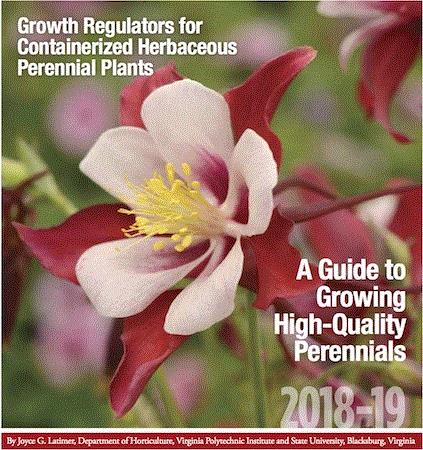
Ball Publishing has released its newest edition of the popular Perennial PGR Guide, which is sponsored by Fine Americas, Inc. This comprehensive guide is a great tool to have on hand as you navigate through the upcoming production season. The guide contains some great content, including the following articles:
Wide Assortment of Available PGRs by Brian Whipker & Joyce Latimer
Tank mixing Configure [BA] with Plant Growth Regulators by Joyce Latimer & Holly Scoggins.
Using Dazide and Concise to Control Growth of Hybrid Echinacea by Mara Grossman, Holly Scoggins & Joyce Latimer
Fresco Use Tips by Brian Whipker
The guide contains a comprehensive table with various PGR rates for obtaining height control or to increase branching—for far too many perennials to mention here. The table is a compilation of Dr. Latimer’s research and data obtained by various researchers (including yours truly) from across the country.
If you’re looking to utilize growth regulators more to improve various aspects of your perennial programs, be sure to get this guide. Click here to download your copy of the Ball Publishing 2018-19 Perennial PGR Guide, sponsored by Fine Americas, Inc.

For All You Brewmeisters
I imagine there are a few subscribers who’ve been known to brew a good lager in their free time and I thought you’d appreciate this recent announcement. The International Herb Association has picked hops as its 2018 Herb of the Year.
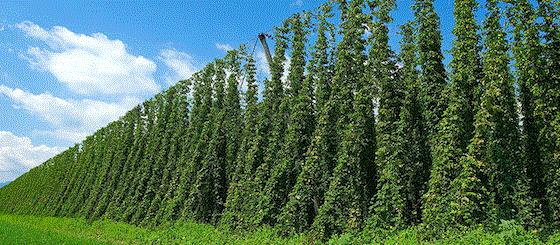
Hops grow vigorously (up to one ft. per day) and can reach 25 to 40 ft. in a single season. They do die back to the ground in the winter. Did you know the roots of hops may grow up to 15 ft. below the soil surface? Hops have fragrant flowers and have been known to attract butterflies.
Hops are used primarily as a flavoring and stability agent in beer making. Hops give beer its distinctive bitter taste. There are easily over 100 cultivars available with flavors ranging from herbal, floral spicy, fruity, citrusy, earthy and evergreen.
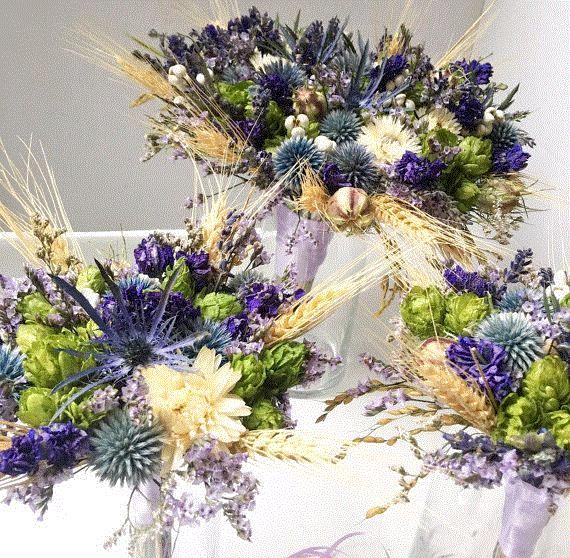
Although hops are used in beer making, they are perennial vines that have a few other uses as well. With their large size, hops can be used for screening undesirable views, a source of shade and to obtain a little privacy. The papery white pine cone structures called strobils can be dried and used in flower arrangements, wreaths and other crafts. Hops have long been used in herbal teas to promote healthy sleep; the dried strobils are also commonly placed into sachets or pillows and used as a relaxant or sleep aid.
The young bines (twining plant stems) can be consumed and are a good source of fiber. Consider trying them in salads, baked or grilled.
So, let’s raise our glasses and congratulate hops as they celebrate the honor of being the International Herb Association’s 2018 Herb of the Year.



Thanks for reading this edition of Perennial Pulse.
I hope your preparations for the upcoming season are going well. Feel free to drop me a line from time to time to give me a status report or to let me know what challenges you're facing. Also, I'm always interested in learning what you'd like to read about in a future Perennial Pulse.
My email is ppilon@ballpublishing.com.
Best regards,
Paul Pilon
Editor-at-Large
Perennial Pulse
This email was received by you and over 33,480 subscribers!
If you're interested in advertising in Perennial Pulse, contact Kim Brown ASAP and she'll hook you up.